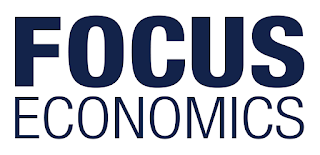Growth held steady in the third quarter, reflecting stable economic performances in the region’s big players. That said, the pace of expansion was modest overall, as the economy was restrained by persistent external headwinds, a weak industrial sector and a cooling labor market. Turning to the fourth quarter, survey-based indicators point to another quarter of sluggish growth. In October, the composite PMI ticked up, although it landed barely above the crucial 50-point threshold. Moreover, economic sentiment plunged to a near five-year low, owing to a broad-based decline in confidence among consumers and businesses.
Meanwhile, in the political arena, elections in Spain produced a deeply fragmented Parliament; although the ruling Socialist party struck a deal with far-left Podemos, they still have to find enough support in Parliament and, even if a new government was sworn in, lawmaking would likely be bumpy.
The economy should continue to expand modestly modest in 2020, following a notable deceleration this year. A challenging external backdrop and weak global growth are set to restrain exports and investment activity. The volatile political environment in Italy and Spain and a possible escalation in trade tensions with the U.S. pose downside risks. Growth is seen at 1.0% in 2020, which is unchanged from last month’s forecast. In 2021, GDP is seen increasing 1.3%.
Harmonized inflation declined to 0.7% in October from September’s 0.8%, the lowest reading since November 2016, mainly on the back of falling energy prices. Inflation thus moved further below the ECB’s target of below, but close to, 2.0%. Price pressures are expected to remain subdued ahead due to below-potential growth and low energy prices. Our panel sees inflation averaging 1.2% in 2020 before picking up to 1.4% in 2021.
The ECB held course on 24 October, leaving all interest rates unchanged. The meeting marked the end of ECB President Mario Draghi’s eight-year tenure, who was replaced by former-IMF head Christine Lagarde. The monetary policy stance is expected to remain ultra-accommodative for a protracted period of time due to weak growth and below-target inflation. Consensus projects the refinancing rate ending 2020 at 0.00% and 2021 at 0.03%.
The euro was little changed over the past month. On 15 November, the currency ended the day at USD 1.11 per EUR, up 0.1% from the same day in October. A high interest rate differential, sluggish GDP growth and trade tensions have kept the euro weak so far this year and these factors are seen persisting into 2020. Our panel sees the euro ending 2020 at USD 1.14 per EUR and 2021 at USD 1.18 per EUR.
REAL SECTOR | Growth surpasses expectations although remains anemic A second preliminary estimate reaffirmed that the Eurozone economy remained soft in the third quarter of 2019, again weighed on by a weak manufacturing sector and uncertainty surrounding global trade. According to Eurostat, GDP increased a seasonally-adjusted 0.2% in Q3 from the previous quarter, matching both Q2’s reading and the first flash estimate—which had surprised market expectations on the upside. Compared with the same quarter of the previous year, seasonally-adjusted GDP expanded 1.2% in Q3, also matching Q2’s increase. The result shows that the Eurozone economy remains stuck in a low gear, likely weighed on by a weak industrial sector amid an unsupportive global trade environment. Outstanding a full breakdown by components, monthly data suggests weakness in the industrial sector likely filtered into the services sector in the quarter. That said, the industrial sector could have turned a corner: Industrial production recorded two consecutive months of sequential, albeit subdued, expansion in August−September; meanwhile, confidence in the services sector declined throughout Q3, and the labor market started to flag, with employment barely rising in the quarter. The soft GDP print, combined with low inflation, highlights the ECB’s ultra-loose monetary policy stance is struggling to boost growth in the bloc. Additional data released by national statistical institutes across the Eurozone was consistent with the picture of stable but sluggish economic growth. Surpassing analysts’ expectations, the economies of Germany and Italy expanded a meagre 0.1% quarter-on-quarter and Germany thus narrowly dodged a technical recession. Meanwhile, France and Spain kept pace in the quarter, growing 0.3% and 0.4% respectively. Although Spain’s growth rate is well below its post-crisis highs, the Iberian economy continues to outperform most of its peers nonetheless. Looking ahead, Peter Vanden Houte, chief economist for Belgium and the Eurozone at ING, noted: “With 0.2% growth quarter-on-quarter, third quarter eurozone GDP growth came in better than expected. However, the economy continues to decelerate and it looks as if the trough in the current slowdown might still be a few months away. With a new president at the helm at the ECB, monetary policy is unlikely to change over the forecasting period”. Meanwhile, Marco Valli, chief European economist at UniCredit, highlighted: “Going forward, the outlook for fixed investment and its impact on the consumers will be key factors in the transmission of external weakness to the eurozone economy. So far, investment in the euro area has remained resilient despite a worsening of firms’ profitability, with the financing based progressively less on funds generated internally by firms, and more on external sources of funding. The latter has mainly reflected exceptionally loose financial conditions in the wake of ECB policies. However, unless firms’ profitability starts turning around soon, investment growth is likely to lose momentum in the coming quarters, which would then spill over more clearly to the labor market”. More comprehensive results for the third quarter including a breakdown by components are scheduled to be released on 20 January. The ECB sees the Eurozone economy growing 1.2% in 2020 and 1.4% in 2021. FocusEconomics Consensus Forecast panelists expect the Euro area economy to expand 1.0% in 2020, which is unchanged from last month’s forecast. For 2021, panelists expect the economy to grow 1.3%.



